There are many reasons why India is such a delightful country to visit, whether you are a foreigner or an Indian tourist. This land is rich in tradition, culture, history, buildings, heritage temples, forts and palaces. There are many famous Indian monuments which include the Old Churches of Goa, Qutub Minar of Delhi, Taj Mahal, Charminar, Red Fort and Jantar Mantar. These are some of the extensively visited cultural and heritage sites in India.
These historical monuments, world heritage sites and natural tourism like national wildlife parks and ancient temples of South India are the only assets of Indian tourism. The wonders of Indian architecture tell a lot about the country’s past, beliefs, culture and artistry. So if you are fond of traveling and love to see the cultural and architectural history of our unique subcontinent, then you must check out these top 10 monuments in India.
1. Taj Mahal, Agra
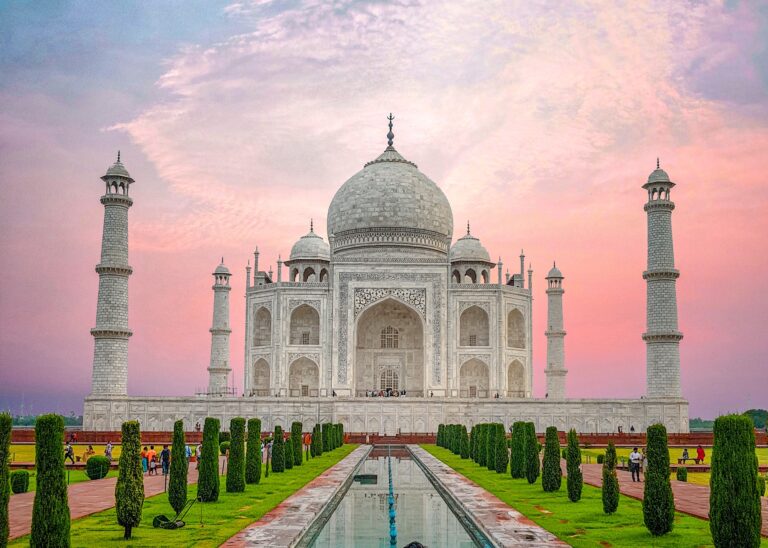
The Taj Mahal, located in Agra, India, is one of the most iconic and exquisite monuments globally, renowned for its stunning beauty and historical significance. It was built between 1632 and 1648 by the Mughal Emperor Shah Jahan in memory of his beloved wife Mumtaz Mahal, who passed away during childbirth.
The Taj Mahal is a masterpiece of Mughal architecture, characterized by its white marble structure adorned with intricate inlaid semi-precious stones and calligraphy from the Quran. Its central dome is flanked by four minarets, creating a symmetrical and breathtaking appearance.
Visitors are captivated by the Taj Mahal’s reflection in the surrounding Yamuna River, especially during sunrise and sunset when its colors change dramatically. Recognized as a UNESCO World Heritage Site, it symbolizes eternal love and is often described as a symbol of India’s rich history, artistry, and cultural heritage, making it a must-visit destination for tourists from around the world.
2. Qutub Minar, Delhi
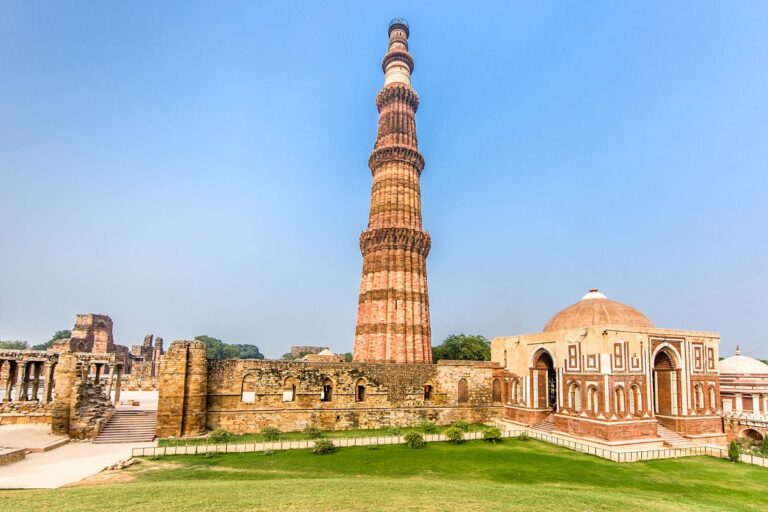
Qutub Minar, located in Delhi, India, is a magnificent architectural marvel and one of the most prominent historical landmarks in the country. It is a UNESCO World Heritage Site and stands as a testament to India’s rich history and architectural prowess.
Built during the 12th century by Qutb-ud-din Aibak, the first Sultan of Delhi from the Mamluk dynasty, and later expanded by subsequent rulers, the Qutub Minar is a towering minaret that reaches a height of 73 meters (239 feet). It is constructed primarily of red sandstone and features intricate carvings and inscriptions from the Quran.
The Qutub Minar complex also includes other notable structures like the Iron Pillar of Delhi, which has baffled scientists due to its rust-resistant composition, and the Quwwat-ul-Islam Mosque, one of the oldest mosques in India.
Visitors to Qutub Minar can explore its historical and architectural significance while enjoying the serene ambiance of the surrounding gardens, making it a must-visit destination for history enthusiasts and tourists alike.
3. Red Fort, Delhi
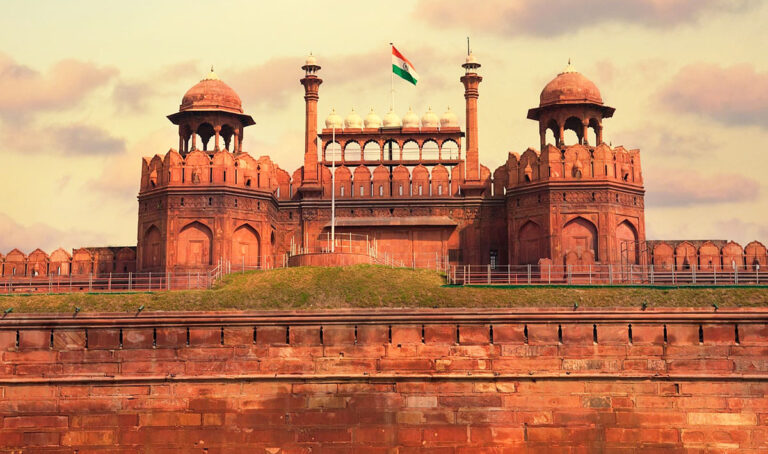
The Red Fort, or “Lal Qila” in Hindi, is an iconic historical monument situated in the heart of Old Delhi, India. It is a UNESCO World Heritage Site and an enduring symbol of India’s rich history and architectural grandeur.
Constructed by the Mughal Emperor Shah Jahan in the mid-17th century, the Red Fort served as the main residence of Mughal emperors for over two centuries. The fort derives its name from the imposing red sandstone walls that encase its vast complex, which covers approximately 255 acres.
The Red Fort features a blend of Persian, Timurid, and Indian architectural styles, with impressive gateways, stunning marble structures, beautiful courtyards, and ornate buildings like the Diwan-i-Aam (Hall of Public Audience) and the Diwan-i-Khas (Hall of Private Audience). The fort is also known for its annual Independence Day celebrations when the Indian Prime Minister hoists the national flag from its ramparts.
A visit to the Red Fort offers a captivating glimpse into India’s historical and cultural heritage, making it a top attraction for tourists and history enthusiasts.
4. Jaipur City Palace, Rajasthan
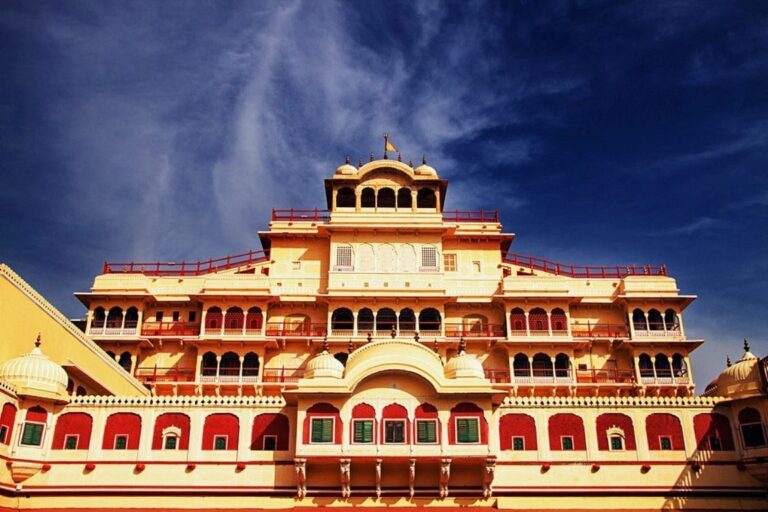
The City Palace in Jaipur, Rajasthan, is a magnificent and historic royal residence that stands as a testament to the opulence and grandeur of the Rajput rulers. Constructed during the 18th century by Maharaja Sawai Jai Singh II, the founder of Jaipur, this sprawling palace complex showcases a splendid fusion of Rajput and Mughal architectural styles.
The City Palace is divided into several courtyards, gardens, and buildings, each offering a unique glimpse into Rajasthan’s royal heritage. The Chandra Mahal, a seven-story palace within the complex, is the current residence of the royal family and is adorned with exquisite artwork, textiles, and artifacts. The Mubarak Mahal, or the Palace of Welcome, houses a museum displaying an extensive collection of royal costumes, weaponry, and artifacts.
Visitors can explore the Diwan-i-Khas (Hall of Private Audience), Diwan-i-Aam (Hall of Public Audience), and the stunning Peacock Gate, known for its intricate peacock motifs. The City Palace is a must-visit destination for those seeking to immerse themselves in Rajasthan’s rich history and cultural heritage.
5. Hawa Mahal, Jaipur

Hawa Mahal, also known as the “Palace of Winds,” is an iconic architectural masterpiece located in Jaipur, Rajasthan, India. Built in 1799 by Maharaja Sawai Pratap Singh, it is a distinctive and captivating structure that epitomizes the fusion of Rajput and Mughal architectural styles.
Hawa Mahal is renowned for its unique five-story exterior, which features 953 small windows or “jharokhas” intricately designed with latticework. These windows were meant to allow the royal women of the palace to observe street festivities and daily life without being seen by the public, given the purdah system of the time. The honeycomb-like façade not only served a functional purpose but also adds to the palace’s aesthetic charm.
Inside, Hawa Mahal has a small museum showcasing artifacts and historical items related to Jaipur’s royal history. The structure itself stands as a symbol of Jaipur’s rich cultural heritage and architectural ingenuity and is a must-visit attraction for tourists exploring the city.
6. Fatehpur Sikri, Uttar Pradesh

Fatehpur Sikri, located in Uttar Pradesh, India, is a historic city and UNESCO World Heritage Site that served as the short-lived Mughal capital during the late 16th century. Built by Emperor Akbar the Great, it is renowned for its stunning architecture and represents a harmonious blend of various cultural influences.
The city boasts several notable structures, including the Buland Darwaza (Gate of Victory), which is one of the tallest gateways in the world and a testament to Akbar’s military successes. The Jama Masjid is a grand and intricately designed mosque within the complex, while the Salim Chishti’s Tomb is a significant pilgrimage site.
The Panch Mahal, Diwan-i-Khas, and Diwan-i-Aam are other impressive buildings showcasing Mughal architecture and administrative functions. Fatehpur Sikri’s architectural brilliance, with its use of red sandstone and white marble, reflects the cultural diversity and artistic achievements of the Mughal era.
Although abandoned due to water shortages, Fatehpur Sikri remains a captivating historical site that offers visitors a glimpse into the glory and grandeur of the Mughal Empire.
7. Khajuraho Group of Monuments, Madhya Pradesh
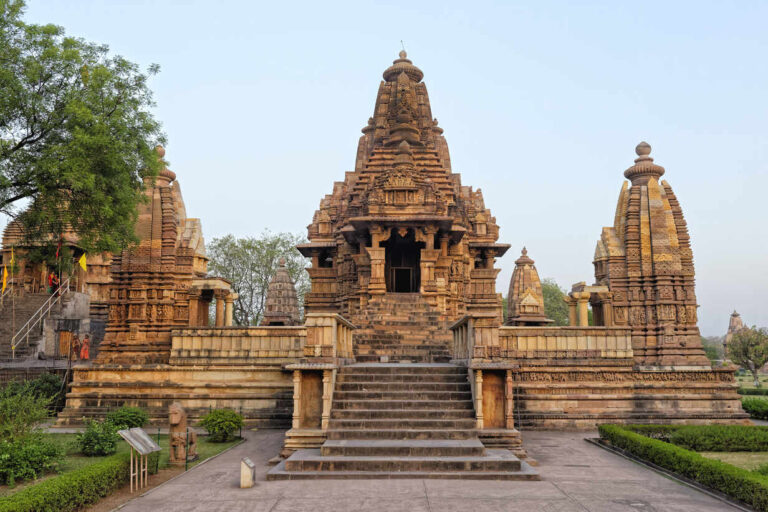
The Khajuraho Group of Monuments is a UNESCO World Heritage Site located in the town of Khajuraho in Madhya Pradesh, India. These stunning temples, built between the 9th and 11th centuries by the Chandela dynasty, are renowned for their intricate and exquisite sculptures, showcasing a unique blend of art, culture, and religion.
The Khajuraho temples are famous for their explicit depictions of various aspects of human life, including sensuality and spirituality. The sculptures are carved in exquisite detail, portraying gods, goddesses, mythical creatures, and everyday life in ancient India. The temples are divided into Western, Eastern, and Southern groups, with the Western Group being the most famous and well-preserved.
The Kandariya Mahadeva Temple, Lakshmana Temple, and Vishvanatha Temple are some of the most notable structures within the complex. These temples reflect the architectural and artistic achievements of the Chandela dynasty and provide a fascinating insight into India’s rich cultural heritage. The Khajuraho Group of Monuments continues to captivate visitors from around the world for its exceptional craftsmanship and historical significance.
8. Hampi, Karnataka
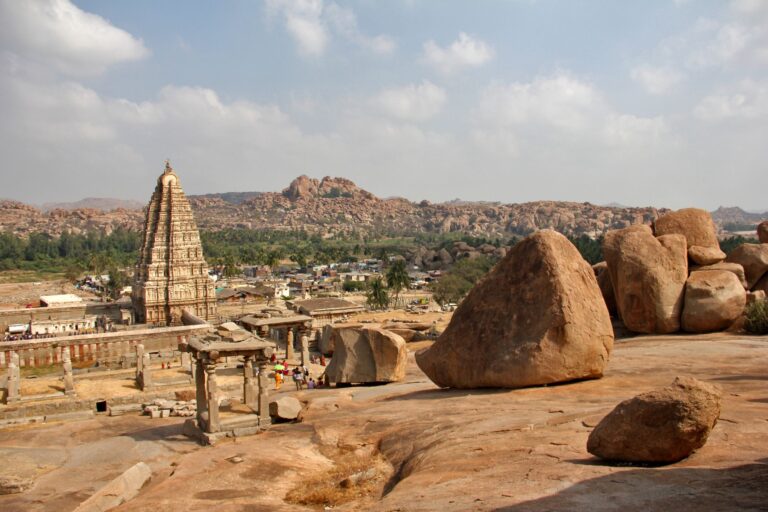
Hampi, located in the state of Karnataka, India, is an ancient and UNESCO World Heritage-listed archaeological site that was once the capital of the Vijayanagara Empire. This sprawling historical complex is renowned for its captivating ruins, majestic temples, and striking boulder-strewn landscape, making it a significant cultural and architectural treasure.
The ruins of Hampi date back to the 14th to 16th centuries and are spread across an expansive area of approximately 26 square kilometers along the banks of the Tungabhadra River. Notable attractions in Hampi include the Virupaksha Temple, known for its 160-foot-tall tower, the Vittala Temple with its iconic stone chariot and musical pillars, and the magnificent Hampi Bazaar.
Visitors to Hampi can explore the remnants of the royal palace, ancient marketplaces, ornate temples, and numerous monolithic statues, all set against a backdrop of dramatic granite rock formations. The unique combination of natural beauty and historical significance makes Hampi a captivating destination for history enthusiasts, architecture lovers, and nature seekers alike.
9. Meenakshi Amman Temple, Madurai
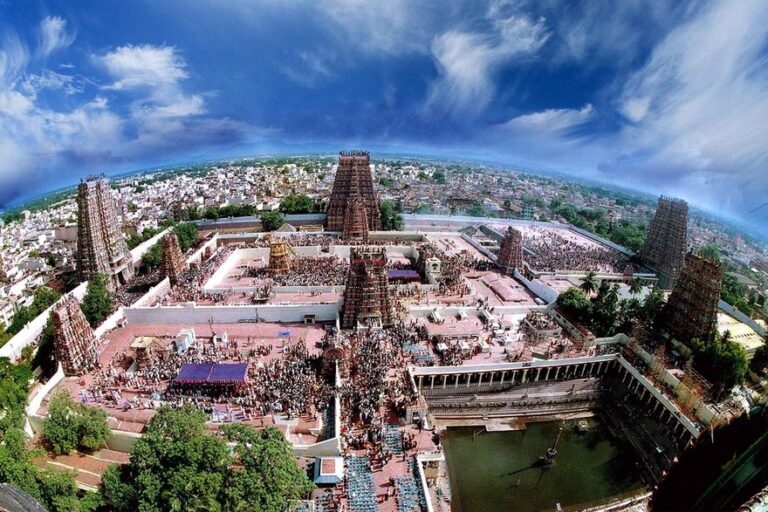
The temple complex is renowned for its intricate Dravidian-style architecture, featuring towering gopurams (pyramidal gateways) adorned with thousands of colorful sculptures depicting various mythological stories and deities. The main gopuram stands at a towering height of around 52 meters (170 feet). The temple is built around a sacred pond known as Porthamarai Kulam (Golden Lotus Tank).
Inside the temple, visitors can admire the exquisite carvings, mandapams (halls), and shrines dedicated to various deities. The Thousand Pillar Hall, an architectural masterpiece, is another highlight.
The Meenakshi Amman Temple is not only a place of religious significance but also a marvel of art and culture, attracting devotees and tourists from all over the world.
10. India Gate, Delhi

The India Gate is a prominent war memorial and iconic landmark located in the heart of New Delhi, the capital city of India. It stands as a tribute to the soldiers of the Indian Army who sacrificed their lives during World War I. The monument was designed by Sir Edwin Lutyens and completed in 1931.
The India Gate is an imposing archway made of red sandstone and granite, standing at a height of 42 meters (138 feet). It is often compared to the Arc de Triomphe in Paris due to its similar architectural style. The names of more than 13,000 soldiers, including British and Indian troops, who died in various conflicts are inscribed on the walls of the gate.
Surrounded by lush lawns, the India Gate serves as a popular gathering place and a symbol of national pride. It is particularly significant on Republic Day (January 26th) when the President of India pays homage to the martyrs, and a grand parade takes place along the ceremonial Rajpath avenue. The India Gate is not only a historic monument but also a symbol of remembrance and patriotism for the Indian people.
